Towards a Digital Information Platform for Locating and Assessing Environmental Impacts of Submarine Groundwater Discharge: Examples from the Baltic Sea
Abstract
1. Introduction
2. Materials and Methods
2.1. Type and Location of the Investigated SGD Sites
2.2. Methods for SGD Detection and Monitoring
2.3. Monitoring SGDs in Time and Space
2.4. Developing Open Access Information Platform (EGDI) Including 3D Model Viewer
3. Selected Results and Examples from Investigated SGD Sites
3.1. Eckernförde, Germany
3.2. Hanko Peninsula, Finland
3.3. Horsens Fjord, Denmark
3.4. Puck Bay, Poland
4. Discussion and Perspectives
5. Conclusions
Supplementary Materials
Author Contributions
Funding
Data Availability Statement
Acknowledgments
Conflicts of Interest
References
- Zektzer, I.S.; Ivanov, V.A.; Meskheteli, A.V. The Problem of Direct Groundwater Discharge to the Seas. J. Hydrol. 1973, 20, 1–36. [Google Scholar] [CrossRef]
- Johannes, R.E. The Ecological Significance of the Submarine Discharge of Groundwater. Mar. Ecol. Prog. Ser. 1980, 3, 365–373. [Google Scholar] [CrossRef]
- Whiticar, M.J.; Werner, F. Pockmarks: Submarine Vents of Natural Gas or Freshwater Seeps? Geo-Mar. Lett. 1981, 1, 193–199. [Google Scholar] [CrossRef]
- Church, T.M. An Underground Route for the Water Cycle. Nature 1996, 380, 579–580. [Google Scholar] [CrossRef]
- Taniguchi, M.; Burnett, W.C.; Cable, J.E.; Turner, J.V. Investigation of Submarine Groundwater Discharge. Hydrol. Process. 2002, 16, 2115–2129. [Google Scholar] [CrossRef]
- Taniguchi, M.; Dulai, H.; Burnett, K.M.; Santos, I.R.; Sugimoto, R.; Stieglitz, T.; Kim, G.; Moosdorf, N.; Burnett, W.C. Submarine Groundwater Discharge: Updates on Its Measurement Techniques, Geophysical Drivers, Magnitudes, and Effects. Front. Environ. Sci. 2019, 7, 141. [Google Scholar] [CrossRef]
- Moore, W.S. Sources and Fluxes of Submarine Groundwater Discharge Delineated by Radium Isotopes. Biogeochemistry 2003, 66, 75–93. [Google Scholar] [CrossRef]
- Burnett, W.C.; Aggarwal, P.K.; Aureli, A.; Bokuniewicz, H.; Cable, J.E.; Charette, M.A.; Kontar, E.; Krupa, S.; Kulkarni, K.M.; Loveless, A.; et al. Quantifying Submarine Groundwater Discharge in the Coastal Zone via Multiple Methods. Sci. Total Environ. 2006, 367, 498–543. [Google Scholar] [CrossRef]
- Burnett, W.C.; Bokuniewicz, H.; Moore, W.S.; Taniguchi, M. Groundwater and pore water inputs to the coastal zone. Biogeochemistry 2003, 66, 3–33. [Google Scholar] [CrossRef]
- Dulai, H.; Santos, I.R.; Taniguchi, M.; Sugimoto, R.; Shoji, J.; Mukherjee, A. Editorial: Submarine Groundwater Discharge: Impacts on Coastal Ecosystem by Hidden Water and Dissolved Materials. Front. Environ. Sci. 2021, 8, 629509. [Google Scholar] [CrossRef]
- Londoño-Londoño, J.E.; de Melo, M.T.C.; Nascimento, J.N.; Silva, A.C.F. Thermal-Based Remote Sensing Solution for Identifying Coastal Zones with Potential Groundwater Discharge. J. Mar. Sci. Eng. 2022, 10, 414. [Google Scholar] [CrossRef]
- McKenzie, T.; Moody, A.; Barreira, J.; Guo, X.; Cohen, A.; Wilson, S.J.; Ramasamy, M. Metals in Coastal Groundwater Systems under Anthropogenic Pressure: A Synthesis of Behavior, Drivers, and Emerging Threats. Limnol. Oceanogr. Lett. 2024, 9, 388–410. [Google Scholar] [CrossRef]
- Wilson, S.J.; Moody, A.; McKenzie, T.; Cardenas, M.B.; Luijendijk, E.; Sawyer, A.H.; Wilson, A.; Michael, H.A.; Xu, B.; Knee, K.L.; et al. Global Subterranean Estuaries Modify Groundwater Nutrient Loading to the Ocean. Limnol. Oceanogr. Lett. 2024, 9, 411–422. [Google Scholar] [CrossRef]
- Arévalo-Martínez, D.L.; Haroon, A.; Bange, H.W.; Erkul, E.; Jegen, M.; Moosdorf, N.; Schneider Von Deimling, J.; Berndt, C.; Böttcher, M.E.; Hoffmann, J.; et al. Ideas and Perspectives: Land-Ocean Connectivity through Groundwater. Biogeosciences 2023, 20, 647–662. [Google Scholar] [CrossRef]
- Jenner, A.K.; Saban, R.; Ehlert von Ahn, C.M.; Roeser, P.; Schmiedinger, I.; Sültenfuβ, J.; Reckhardt, A.; Böttcher, M.E. Different Continuous Freshwater Contributions to Submarine Groundwater Discharge at a Coastal Peatland, Southern Baltic Sea. Isotopes Environ. Health Stud. 2024. [Google Scholar] [CrossRef]
- von Ahn, C.M.E.; Dellwig, O.; Szymczycha, B.; Kotwicki, L.; Rooze, J.; Endler, R.; Escher, P.; Schmiedinger, I.; Sültenfuß, J.; Diak, M.; et al. Submarine Groundwater Discharge into a Semi-Enclosed Coastal Bay of the Southern Baltic Sea: A Multi-Method Approach. Oceanologia 2024, 66, 111–138. [Google Scholar] [CrossRef]
- von Ahn, C.M.E.; Scholten, J.C.; Malik, C.; Feldens, P.; Liu, B.; Dellwig, O.; Jenner, A.K.; Papenmeier, S.; Schmiedinger, I.; Zeller, M.A.; et al. A Multi-Tracer Study of Fresh Water Sources for a Temperate Urbanized Coastal Bay (Southern Baltic Sea). Front. Environ. Sci. 2021, 9, 642346. [Google Scholar] [CrossRef]
- Zhang, X.; Li, H.; Wang, X.; Kuang, X.; Zhang, Y.; Xiao, K.; Xu, C. A Comprehensive Analysis of Submarine Groundwater Discharge and Nutrient Fluxes in the Bohai Sea, China. Water Res. 2024, 253, 121320. [Google Scholar] [CrossRef]
- Virtasalo, J.J.; Schröder, J.F.; Luoma, S.; Majaniemi, J.; Mursu, J.; Scholten, J. Submarine Groundwater Discharge Site in the First Salpausselkä Ice-Marginal Formation, South Finland. Solid Earth 2019, 10, 405–423. [Google Scholar] [CrossRef]
- Luoma, S.; Majaniemi, J.; Pullinen, A.; Mursu, J.; Virtasalo, J.J. Geological and Groundwater Flow Model of a Submarine Groundwater Discharge Site at Hanko (Finland), Northern Baltic Sea. Hydrogeol. J. 2021, 29, 1279–1297. [Google Scholar] [CrossRef]
- Szymczycha, B.; Miotk, M.; Pempkowiak, J. Submarine Groundwater Discharge as a Source of Mercury in the Bay of Puck, the Southern Baltic Sea. Water Air Soil Pollut. 2013, 224, 1542. [Google Scholar] [CrossRef] [PubMed]
- Szymczycha, B.; Vogler, S.; Pempkowiak, J. Nutrient Fluxes via Submarine Groundwater Discharge to the Bay of Puck, Southern Baltic Sea. Sci. Total Environ. 2012, 438, 86–93. [Google Scholar] [CrossRef] [PubMed]
- Szymczycha, B.; Kroeger, K.D.; Pempkowiak, J. Significance of Groundwater Discharge along the Coast of Poland as a Source of Dissolved Metals to the Southern Baltic Sea. Mar. Pollut. Bull. 2016, 109, 151–162. [Google Scholar] [CrossRef]
- Szymczycha, B.; Kłostowska, Z.; Lengier, M.; Dzierzbicka-głowacka, L. Significance of Nutrient Fluxes via Submarine Groundwater Discharge in the Bay of Puck, Southern Baltic Sea. Oceanologia 2020, 62, 117–125. [Google Scholar] [CrossRef]
- Szymczycha, B.; Borecka, M.; Bia, A.; Siedlewicz, G.; Pazdro, K. Science of the Total Environment Submarine Groundwater Discharge as a Source of Pharmaceutical and Caffeine Residues in Coastal Ecosystem: Bay of Puck, Southern Baltic Sea Case Study. Sci. Total Environ. 2020, 713, 136522. [Google Scholar] [CrossRef]
- Kłostowska, Ż.; Szymczycha, B.; Lengier, M.; Zarzeczańska, D.; Dzierzbicka-Głowacka, L. Hydrogeochemistry and Magnitude of SGD in the Bay of Puck, Southern Baltic Sea. Oceanologia 2020, 62, 1–11. [Google Scholar] [CrossRef]
- Matciak, M.; Misiewicz, M.M.; Szymczycha, B.; Idczak, J.; Tęgowski, J.; Diak, M. Pockmarks and Associated Fresh Submarine Groundwater Discharge in the Seafloor of Puck Bay, Southern Baltic Sea. Sci. Total Environ. 2024, 942, 173617. [Google Scholar] [CrossRef]
- Szymczycha, B.; Böttcher, M.E.; Diak, M.; Koziorowska-Makuch, K.; Kuliński, K.; Makuch, P.; von Ahn, C.M.E.; Winogradow, A. The Benthic-Pelagic Coupling Affects the Surface Water Carbonate System above Groundwater-Charged Coastal Sediments. Front. Mar. Sci. 2023, 10, 1218245. [Google Scholar] [CrossRef]
- Kreuzburg, M.; Scholten, J.; Hsu, F.-H.; Liebetrau, V.; Sültenfuß, J.; Rapaglia, J.; Schlüter, M. Submarine Groundwater Discharge-Derived Nutrient Fluxes in Eckernförde Bay (Western Baltic Sea). Estuaries Coasts 2023, 46, 1190–1207. [Google Scholar] [CrossRef]
- Dang, M.Q.; Hsu, F.H.; Su, C.C.; Wang, S.J.; Fu, C.C.; Lin, I.T. Investigation of Seasonal Variations in Submarine Groundwater Discharge Using Radium Isotopes under Drought Conditions in Northwestern Coastal Taiwan. J. Hydrol. 2025, 649, 132450. [Google Scholar] [CrossRef]
- Hinsby, K.; Markager, S.; Kronvang, B.; Windolf, J.; Sonnenborg, T.O.; Thorling, L. Threshold Values and Management Options for Nutrients in a Catchment of a Temperate Estuary with Poor Ecological Status. Hydrol. Earth Syst. Sci. 2012, 16, 2663–2683. [Google Scholar] [CrossRef]
- European Commission. Technical Report on Groundwater Associated Aquatic Ecosystems; European Commission: Brussels, Belgium, 2015.
- Andersen, M.S.; Baron, L.; Gudbjerg, J.; Gregersen, J.; Chapellier, D.; Jakobsen, R.; Postma, D. Discharge of Nitrate-Containing Groundwater into a Coastal Marine Environment. J. Hydrol. 2007, 336, 98–114. [Google Scholar] [CrossRef]
- Moore, W.S.; Blanton, J.O.; Joye, S.B. Estimates of Flushing Times, Submarine Groundwater Discharge, and Nutrient Fluxes to Okatee Estuary, South Carolina. J. Geophys. Res. Oceans 2006, 111, 1–14. [Google Scholar] [CrossRef]
- Luijendijk, E.; Gleeson, T.; Moosdorf, N. Fresh Groundwater Discharge Insignificant for the World’s Oceans but Important for Coastal Ecosystems. Nat. Commun. 2020, 11, 1260. [Google Scholar] [CrossRef]
- Schlüter, M.; Sauter, E.J.; Andersen, C.E.; Dahlgaard, H.; Dando, P.R. Spatial Distribution and Budget for Submarine Groundwater Discharge in Eckernförde Bay (Western Baltic Sea). Limnol. Oceanogr. 2004, 49, 157–167. [Google Scholar] [CrossRef]
- Slomp, C.P.; Van Cappellen, P. Nutrient Inputs to the Coastal Ocean through Submarine Groundwater Discharge: Controls and Potential Impact. J. Hydrol. 2004, 295, 64–86. [Google Scholar] [CrossRef]
- Smith, S.L.; Cunniff, S.E.; Peyronnin, N.S.; Kritzer, J.P. Prioritizing Coastal Ecosystem Stressors in the Northeast United States under Increasing Climate Change. Environ. Sci. Policy 2017, 78, 49–57. [Google Scholar] [CrossRef]
- Liu, Y.; Song, Y.; Jiao, J.J. Submarine Groundwater Discharge Strengthens Acidification in the Coastal Semi-Closed Bays. Geophys. Res. Lett. 2023, 50, e2023GL103788. [Google Scholar] [CrossRef]
- Moore, W.S. The Effect of Submarine Groundwater Discharge on the Ocean. Ann. Rev. Mar. Sci. 2010, 2, 59–88. [Google Scholar] [CrossRef]
- Wang, X.; Li, H.; Jiao, J.J.; Barry, D.A.; Li, L.; Luo, X.; Wang, C.; Wan, L.; Wang, X.; Jiang, X.; et al. Submarine Fresh Groundwater Discharge into Laizhou Bay Comparable to the Yellow River Flux. Sci. Rep. 2015, 5, 8814. [Google Scholar] [CrossRef]
- Hinsby, K.; Leth, J.O.; Andersen, L.T.; Kidmose, J.; Bennike, O.; Jakobsen, R.; Scholten, J.; Schröder, J.F.; Christensen, F.E.; Christiansen, A.V. Combining Land and Marine Geoscientific Mapping and Modelling to Explore Submarine Groundwater Discharge in a ”white Ribbon” of an Eutrophic Estuary in the Western Baltic Sea. Geus Bull. 2025; submitted. [Google Scholar]
- Lane, J.W.; Briggs, M.A.; Maurya, P.K.; White, E.A.; Pedersen, J.B.; Auken, E.; Terry, N.; Minsley, B.; Kress, W.; LeBlanc, D.R.; et al. Characterizing the Diverse Hydrogeology Underlying Rivers and Estuaries Using New Floating Transient Electromagnetic Methodology. Sci. Total Environ. 2020, 740, 140074. [Google Scholar] [CrossRef] [PubMed]
- Bonus Seamount New Surveillance Tools for Remote Sea Monitoring and Their Application on Submarine Groundwater Discharge and Seabed Surveys—What We Are Doing and Why? Available online: https://seamount.eu/news/video-what-are-we-doing-and-why/ (accessed on 29 January 2025).
- Cai, K.; Zhang, G.; Sun, Y.; Ding, G.; Xu, F. Multi Autonomous Underwater Vehicle (AUV) Distributed Collaborative Search Method Based on a Fuzzy Clustering Map and Policy Iteration. J. Mar. Sci. Eng. 2024, 12, 1521. [Google Scholar] [CrossRef]
- Zhou, J.; Si, Y.; Chen, Y. A Review of Subsea AUV Technology. J. Mar. Sci. Eng. 2023, 11, 1119. [Google Scholar] [CrossRef]
- Bandyopadhyay, P.R. Trends in Biorobotic Autonomous Undersea Vehicles. IEEE J. Ocean. Eng. 2005, 30, 109–139. [Google Scholar] [CrossRef]
- Wynn, R.B.; Huvenne, V.A.I.; Le Bas, T.P.; Murton, B.J.; Connelly, D.P.; Bett, B.J.; Ruhl, H.A.; Morris, K.J.; Peakall, J.; Parsons, D.R.; et al. Autonomous Underwater Vehicles (AUVs): Their Past, Present and Future Contributions to the Advancement of Marine Geoscience. Mar. Geol. 2014, 352, 451–468. [Google Scholar] [CrossRef]
- Reusch, T.B.H.; Dierking, J.; Andersson, H.C.; Bonsdorff, E.; Carstensen, J.; Casini, M.; Czajkowski, M.; Hasler, B.; Hinsby, K.; Hyytiäinen, K.; et al. The Baltic Sea as a Time Machine for the Future Coastal Ocean. Sci. Adv. 2018, 4, eaar8195. [Google Scholar] [CrossRef]
- Meier, H.E.M.; Eilola, K.; Almroth-Rosell, E.; Schimanke, S.; Kniebusch, M.; Höglund, A.; Pemberton, P.; Liu, Y.; Väli, G.; Saraiva, S. Disentangling the Impact of Nutrient Load and Climate Changes on Baltic Sea Hypoxia and Eutrophication since 1850. Clim. Dyn. 2019, 53, 1145–1166. [Google Scholar] [CrossRef]
- Meier, H.E.M.; Kniebusch, M.; Dieterich, C.; Gröger, M.; Zorita, E.; Elmgren, R.; Myrberg, K.; Ahola, M.P.; Bartosova, A.; Bonsdorff, E.; et al. Climate Change in the Baltic Sea Region: A Summary. Earth Syst. Dyn. 2022, 13, 457–593. [Google Scholar] [CrossRef]
- Andersen, J.H.; Carstensen, J.; Conley, D.J.; Dromph, K.; Fleming-Lehtinen, V.; Gustafsson, B.G.; Josefson, A.B.; Norkko, A.; Villnäs, A.; Murray, C. Long-Term Temporal and Spatial Trends in Eutrophication Status of the Baltic Sea. Biol. Rev. 2017, 92, 135–149. [Google Scholar] [CrossRef]
- Carstensen, J.; Andersen, J.H.; Gustafsson, B.G.; Conley, D.J. Deoxygenation of the Baltic Sea during the Last Century. Proc. Natl. Acad. Sci. USA 2014, 111, 5628–5633. [Google Scholar] [CrossRef] [PubMed]
- Reckermann, M.; Omstedt, A.; Soomere, T.; Aigars, J.; Akhtar, N.; Bełdowska, M.; Bełdowski, J.; Cronin, T.; Czub, M.; Eero, M.; et al. Human Impacts and Their Interactions in the Baltic Sea Region. Earth Syst. Dyn. 2022, 13, 1–80. [Google Scholar] [CrossRef]
- Diaz, R.J.; Rosenberg, R. Spreading Dead Zones and Consequences for Marine Ecosystems. Science 2008, 321, 926–929. [Google Scholar] [CrossRef] [PubMed]
- HELCOM. State of the Baltic Sea. Third HELCOM Holistic Assessment 2016–2021; HELCOM: Helsinki, Finland, 2023. [Google Scholar]
- Jarvenpaa, S.L.; Essén, A. Data Sustainability: Data Governance in Data Infrastructures across Technological and Human Generations. Inf. Organ. 2023, 33, 100449. [Google Scholar] [CrossRef]
- Wilkinson, M.; Dumontier, M.; Aalbersberg, I. The FAIR Guiding Principles for Scientific Data Management and Stewardship. Sci. Data 2016, 3, 160018. [Google Scholar] [CrossRef]
- Hinsby, K.; Négrel, P.; de Oliveira, D.; Barros, R.; Venvik, G.; Ladenberger, A.; Griffioen, J.; Piessens, K.; Calcagno, P.; Götzl, G.; et al. Mapping and Understanding Earth: Open Access to Digital Geoscience Data and Knowledge Supports Societal Needs and UN Sustainable Development Goals. Int. J. Appl. Earth Obs. Geoinf. 2024, 130, 103835. [Google Scholar] [CrossRef]
- Prampolini, M.; Savini, A.; Foglini, F.; Soldati, M. Seven Good Reasons for Integrating Terrestrial and Marine Spatial Datasets in Changing Environments. Water 2020, 12, 2221. [Google Scholar] [CrossRef]
- Post, V.E.A.; Groen, J.; Kooi, H.; Person, M.; Ge, S.; Edmunds, W.M. Offshore Fresh Groundwater Reserves as a Global Phenomenon. Nature 2013, 504, 71–78. [Google Scholar] [CrossRef]
- Ladouche, B.; Maréchal, J.C.; Lamotte, C.; Durand, V.; Bailly-Comte, V.; Hakoun, V. Dataset on Onshore Groundwaters and Offshore Submarine Spring of a Mediterranean Karst Aquifer during Flow Reversal and Saltwater Intrusion. Data Brief 2023, 50, 109557. [Google Scholar] [CrossRef]
- EuroGeoSurveys. EuroGeoSurveys—Bridging Science and Policy. Available online: https://eurogeosurveys.org/ (accessed on 30 January 2025).
- Van Gessel, S.F.; Hinsby, K.; Stanley, G.; Tulstrup, J.; Schavemaker, Y.; Piessens, K.; Bogaard, P.J.F. Geological Services towards a Sustainable Use and Management of the Subsurface: A Geoethical Imperative. Ann. Geophys. 2017, 60. [Google Scholar] [CrossRef]
- European Commission. Directive 2006/118/EC of the European Parliament and of the Council of 12 December 2006 on the Protection of Groundwater against Pollution and Deterioration; European Commission: Brussels, Belgium, 2006.
- European Commission. Directive 2000/60/EC of the European Parliament and of the Council of 23 October 2000 Establishing a Framework for Community Action in the Field of Water Policy; European Commission: Brussels, Belgium, 2000.
- European Commission. Directive 2008/56/EC of the European Parliament and of the Council of 17 June 2008 Establishing a Framework for Community Action in the Field of Marine Environmental Policy (Marine Strategy Framework Directive); European Commission: Brussels, Belgium, 2008.
- Cornell, S.; Berkhout, F.; Tuinstra, W.; Tàbara, J.D.; Jäger, J.; Chabay, I.; de Wit, B.; Langlais, R.; Mills, D.; Moll, P.; et al. Opening up Knowledge Systems for Better Responses to Global Environmental Change. Environ. Sci. Policy 2013, 28, 60–70. [Google Scholar] [CrossRef]
- Gleeson, T.; Wang-Erlandsson, L.; Porkka, M.; Zipper, S.C.; Jaramillo, F.; Gerten, D.; Fetzer, I.; Cornell, S.E.; Piemontese, L.; Gordon, L.J.; et al. Illuminating Water Cycle Modifications and Earth System Resilience in the Anthropocene. Water Resour. Res. 2020, 56, e2019WR024957. [Google Scholar] [CrossRef]
- Richardson, K.; Steffen, W.; Lucht, W.; Bendtsen, J.; Cornell, S.E.; Donges, J.F.; Drüke, M.; Fetzer, I.; Bala, G.; Von Bloh, W.; et al. Earth beyond Six of Nine Planetary Boundaries. Sci. Adv. 2023, 9, eadh2458. [Google Scholar] [CrossRef] [PubMed]
- Steffen, W.; Richardson, K.; Rockström, J.; Cornell, S.E.; Fetzer, I.; Bennett, E.M.; Biggs, R.; Carpenter, S.R.; De Vries, W.; De Wit, C.A.; et al. Planetary Boundaries: Guiding Human Development on a Changing Planet. Science 2015, 347, 1259855. [Google Scholar] [CrossRef]
- Walther, G.; Post, E.; Convey, P.; Menzel, A.; Parmesank, C.; Beebee, T.J.C.; Fromentin, J.-M.; Hoegh-Guldberg, O.; Bairlein, F. Ecological Response to Recent Climate Change. Nature 2002, 416, 389–395. [Google Scholar] [CrossRef]
- Hoffmann, J.J.L.; Schneider von Deimling, J.; Schröder, J.F.; Schmidt, M.; Held, P.; Crutchley, G.J.; Scholten, J.; Gorman, A.R. Complex Eyed Pockmarks and Submarine Groundwater Discharge Revealed by Acoustic Data and Sediment Cores in Eckernförde Bay, SW Baltic Sea. Geochem. Geophys. Geosystems 2020, 21, e2019GC008825. [Google Scholar] [CrossRef]
- Ikonen, J.; Hendriksson, N.; Luoma, S.; Lahaye, Y.; Virtasalo, J.J. Behavior of Li, S and Sr Isotopes in the Subterranean Estuary and Seafloor Pockmarks of the Hanko Submarine Groundwater Discharge Site in Finland, Northern Baltic Sea. Appl. Geochem. 2022, 147, 105471. [Google Scholar] [CrossRef]
- Purkamo, L.; von Ahn, C.M.E.; Jilbert, T.; Muniruzzaman, M.; Bange, H.W.; Jenner, A.-K.; Böttcher, M.E.; Virtasalo, J.J. Impact of Submarine Groundwater Discharge on Biogeochemistry and Microbial Communities in Pockmarks. Geochim. Cosmochim. Acta 2022, 334, 14–44. [Google Scholar] [CrossRef]
- Idczak, J.; Brodecka-Goluch, A.; Łukawska-Matuszewska, K.; Graca, B.; Gorska, N.; Klusek, Z.; Pezacki, P.D.; Bolałek, J. A Geophysical, Geochemical and Microbiological Study of a Newly Discovered Pockmark with Active Gas Seepage and Submarine Groundwater Discharge (MET1-BH, Central Gulf of Gdańsk, Southern Baltic Sea). Sci. Total Environ. 2020, 742, 140306. [Google Scholar] [CrossRef]
- Krek, A.; Danchenkov, A.; Mikhnevich, G. Morphological and Chemical Features of Submarine Groundwater Discharge Zones in the South-Eastern Part of the Baltic Sea. Russ. J. Earth Sci. 2022, 22, ES4003. [Google Scholar] [CrossRef]
- EGDI. Interactive Map Showing the Location of SGD Sites Investigated in Coastal Waters of the Baltic Sea. Available online: https://maps.europe-geology.eu/#baslay=baseMapGEUS&e-tent=192526.50754193496,1981300.3554729372,8882255.512591414,5534832.147915851&layers=onegeoeuro_surface_lithology,emodnet_substrate_1m,sgd_locations_epsg3034_2024 (accessed on 28 January 2025).
- INSPIRE. Infrastructure for Spatial Information in Europe. 2025. Available online: https://knowledge-base.inspire.ec.europa.eu/index_en (accessed on 6 March 2025).
- Evologics. Introducing-Seamount-Poggy-a-Novel-Bionic-Auv-from-Evologics; Evologics: Berlin, Germany, 2020; Available online: https://www.evologics.com/blog/news-2/introducing-seamount-poggy-a-novel-bionic-auv-from-evologics-57 (accessed on 6 March 2025).
- NOA-MARINE. Sea Sentinel AUV Capability Demo; NOA MARINE: Kraków, Poland, 2020; Available online: https://www.dropbox.com/scl/fo/nb7jscf6b9pr0wpzjlaz6/AGnyyK7-ADhzyVcKNL78IhQ?rlkey=iblbgmr9xv8a1bfd75jelf4uk&st=0f86y7fu&dl=0 (accessed on 6 March 2025).
- Bannasch, R.; Latacz, M.; Schröder, J.F.; Prien, R.; Virtasalo, J.; Hac, B.; Hinsby, K. Designing and Testing Autonomous Underwater Vehicles for Locating and Monitoring Submarine Groundwater Discharge. In Proceedings of the Baltic Sea Science Congress 2019, Stockholm, Sweden, 19–23 August 2019; Stockholm University: Stockholm, Sweden, 2019; p. 81. [Google Scholar]
- Skålvik, A.M.; Bjørk, R.N.; Martínez, E.; Frøysa, K.-E.; Saetre, C. Multivariate, Automatic Diagnostics Based on Insights into Sensor Technology. J. Mar. Sci. Eng. 2024, 12, 2367. [Google Scholar] [CrossRef]
- EGDI. Real-Time Measurements of Nitrate at St. Blaakilde/the “Big Blue Spring” Denmark. Available online: https://data.geus.dk/sensornet/egditimeseries/index.html?country=denmark&chart=nitrate&locale=en-GB&id-list=StoreBl%E5kilde_1 (accessed on 30 January 2025).
- EGDI. European Geological Data Infrastructure. Available online: https://www.europe-geology.eu/ (accessed on 30 January 2025).
- Hollis, J.; Bricker, S.; Čápová, D.; Hinsby, K.; Krenmayr, H.-G.; Negrel, P.; Oliveira, D.; Poyiadji, E.; Van Gessel, S.; Van Heteren, S.; et al. Pan-European Geological Data, Information, and Knowledge for a Resilient, Sustainable, and Collaborative Future. Eur. Geol. 2022, 53, 6–19. [Google Scholar] [CrossRef]
- European Commission. European Marine Observation and Data Network. Available online: https://emodnet.ec.europa.eu/en (accessed on 29 January 2025).
- GeoERA. Establishing the European Geological Surveys Research Area to Deliver a Geological Service for Europe. Available online: https://geoera.eu/ (accessed on 29 January 2025).
- GSEU. GSEU—Geological Service for Europe: Bringing the Subsurface into the Light. Available online: https://www.geologicalservice.eu/ (accessed on 29 January 2025).
- EPOS. EPOS—European Plate Observing System. Available online: https://www.epos-eu.org/ (accessed on 29 January 2025).
- EGDI. EGDI 3D Model Viewer. Available online: https://3dviewer.europe-geology.eu/?model_id=12 (accessed on 30 January 2025).
- Czech Geological Survey Cookbook for Creating Metadata Records Using the EGDI Metadata Catalogue (MIcKA, Version 6.0). Available online: https://czechgeologicalsurvey.github.io/MICKA-Docs/ (accessed on 13 February 2025).
- EGDI. Information and Support on Providing Data and Metadata for EGDI. Available online: https://www.europe-geology.eu/get-involved/ (accessed on 6 February 2025).
- Bussmann, I.; Suess, E. Groundwater Seepage in Eckernförde Bay (Western Baltic Sea): Effect on Methane and Salinity Distribution of the Water Column. Cont. Shelf Res. 1998, 18, 1795–1806. [Google Scholar] [CrossRef]
- Schubert, M.; Scholten, J.; Kreuzburg, M.; Petermann, E.; de Paiva, M.L.; Köhler, D.; Liebetrau, V.; Rapaglia, J.; Schlüter, M. Radon (222Rn) as Tracer for Submarine Groundwater Discharge Investigation—Limitations of the Approach at Shallow Wind-Exposed Coastal Settings. Environ. Monit. Assess. 2022, 194, 798. [Google Scholar] [CrossRef] [PubMed]
- Ellins’, K.K.; Roman-Mas, A.; Lee, R. Using 222Rn to examine groundwater/surface discharge interaction in the rio grande de manati, puerto rico. J. Hydrol. 1990, 115, 319–341. [Google Scholar] [CrossRef]
- Pedersen, J.; Johnsen, R.; Henriksen, H.J. Horsens Fjord Case—NONAM Risk Assessment and Stakeholder Investment. Multidisciplinary Workshop in Reykjavík 26–27 August 2010. Available online: https://en.vedur.is/media/loftslag/Case_A___Horsens_Fjord.pdf (accessed on 13 February 2025).
- Hinsby, K.; Leth, J.O.; Andersen, L.T.; Kidmose, J.; Thorling, L.; Schröder, J.F.; Scholten, J.; Lanstorp, J.; Hansen, M. Locating and Investigating Submarine Groundwater Discharge in the Horsens Fjord Estuary, Denmark. In Proceedings of the Baltic Sea Science Congress 2019 Abstracts; Stockholm University: Stockholm, Sweden, 2019; p. 114. [Google Scholar]
- IGIS. GeoScene3D—Geological Modelling Software Developed by Geologists for Geologists. Available online: https://i-gis.dk/geoscene3d/ (accessed on 13 February 2025).
- Havsans Low Cost Solutions for Measuring Hydrographic Parameters in Coastal Seas. Available online: https://www.havsans.dk/ (accessed on 30 January 2025).
- Jankowska, H.; Matciak, M.; Nowacki, J. Salinity Variations as an Effect of Groundwater Seepage through the Seabed (Puck Bay, Poland) Puck Bay Salinity Variations Submarine Groundwater Discharge. Oceanologia 1994, 36, 33–46. [Google Scholar]
- Matciak, M.; Pruszkowska-Caceres, M.; Szymczycha, B.; Kobos, J.; Misiewicz, M.M.; Owsianny, P.M. Submarine Groundwater Discharge to the Puck Bay. In Zatoka Pucka, Aspekty Geologiczne i Fizyczne; Bołaek, J., Burska, D., Eds.; Wyd. Uniwersytet Gdański: Gdański, Poland, 2020; pp. 115–169. [Google Scholar]
- Hinsby, K.; Condesso de Melo, M.T.; Dahl, M. European Case Studies Supporting the Derivation of Natural Background Levels and Groundwater Threshold Values for the Protection of Dependent Ecosystems and Human Health. Sci. Total Environ. 2008, 401, 1–20. [Google Scholar] [CrossRef]
- BONUS. BONUS—Science for a Better Future of the Baltic Sea Region. Available online: https://www.bonusportal.org/ (accessed on 30 January 2025).
- BANOS. The Baltic and North Sea Coordination and Support Action (BANOS CSA, 2018–2021). Available online: https://www.banoscsa.org/ (accessed on 30 January 2025).
- Jørgensen, F.; Scheer, W.; Thomsen, S.; Sonnenborg, T.O.; Hinsby, K.; Wiederhold, H.; Schamper, C.; Burschil, T.; Roth, B.; Kirsch, R.; et al. Transboundary Geophysical Mapping of Geological Elements and Salinity Distribution Critical for the Assessment of Future Sea Water Intrusion in Response to Sea Level Rise. Hydrol. Earth Syst. Sci. 2012, 16, 1845–1862. [Google Scholar] [CrossRef]
- Hinsby, K.; Auken, E.; Oude-Essink, G.H.P.; de Louw, P.; Jørgensen, F.; Siemon, B.; Sonnenborg, T.O.; Vandenbohede, A.; Wiederholt, H.; Guadagnini, A.; et al. Assessing the Impact of Climate Change for Adaptive Water Management in Coastal Regions. Hydrol. Earth Syst. Sci. 2011, 16, 149. [Google Scholar]
- Water4All—Water Security for the Planet. SentinelSprings—Springs as Sentinels of Climate Change and Sustainability of Aquatic Ecosystems. 2025. Available online: https://www.water4all-partnership.eu/joint-activities/water4all-2023-joint-transnational-call (accessed on 6 March 2025).
- Luoma, S.; Okkonen, J.; Korkka-Niemi, K. Comparaison Des Méthodes AVI, SINTACS Modifiée et GALDIT d’évaluation de La Vulnérabilité d’un Aquifère Côtier Peu Profond Dans Le Sud de La Finlande Pour Des Scénarios de Changement Climatique. Hydrogeol. J. 2017, 25, 203–222. [Google Scholar] [CrossRef]
- Pellikka, H.; Leijala, U.; Johansson, M.M.; Leinonen, K.; Kahma, K.K. Future Probabilities of Coastal Floods in Finland. Cont. Shelf Res. 2018, 157, 32–42. [Google Scholar] [CrossRef]
- Albers, C.N.; Sültenfuss, J. A 60-Year Increase in the Ultrashort-Chain PFAS Trifluoroacetate and Its Suitability as a Tracer for Groundwater Age. Environ. Sci. Technol. Lett. 2024, 11, 1090–1095. [Google Scholar] [CrossRef]
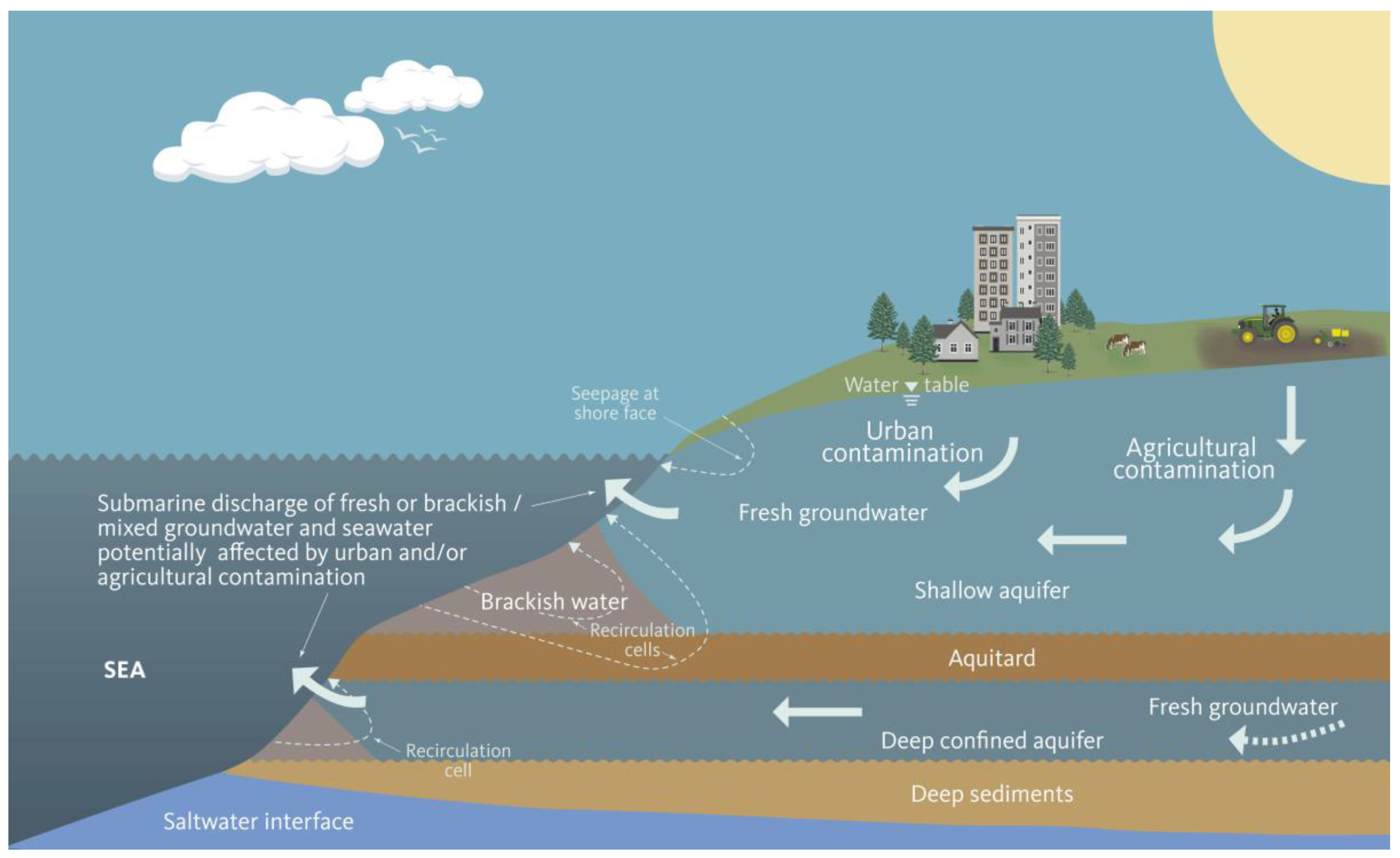
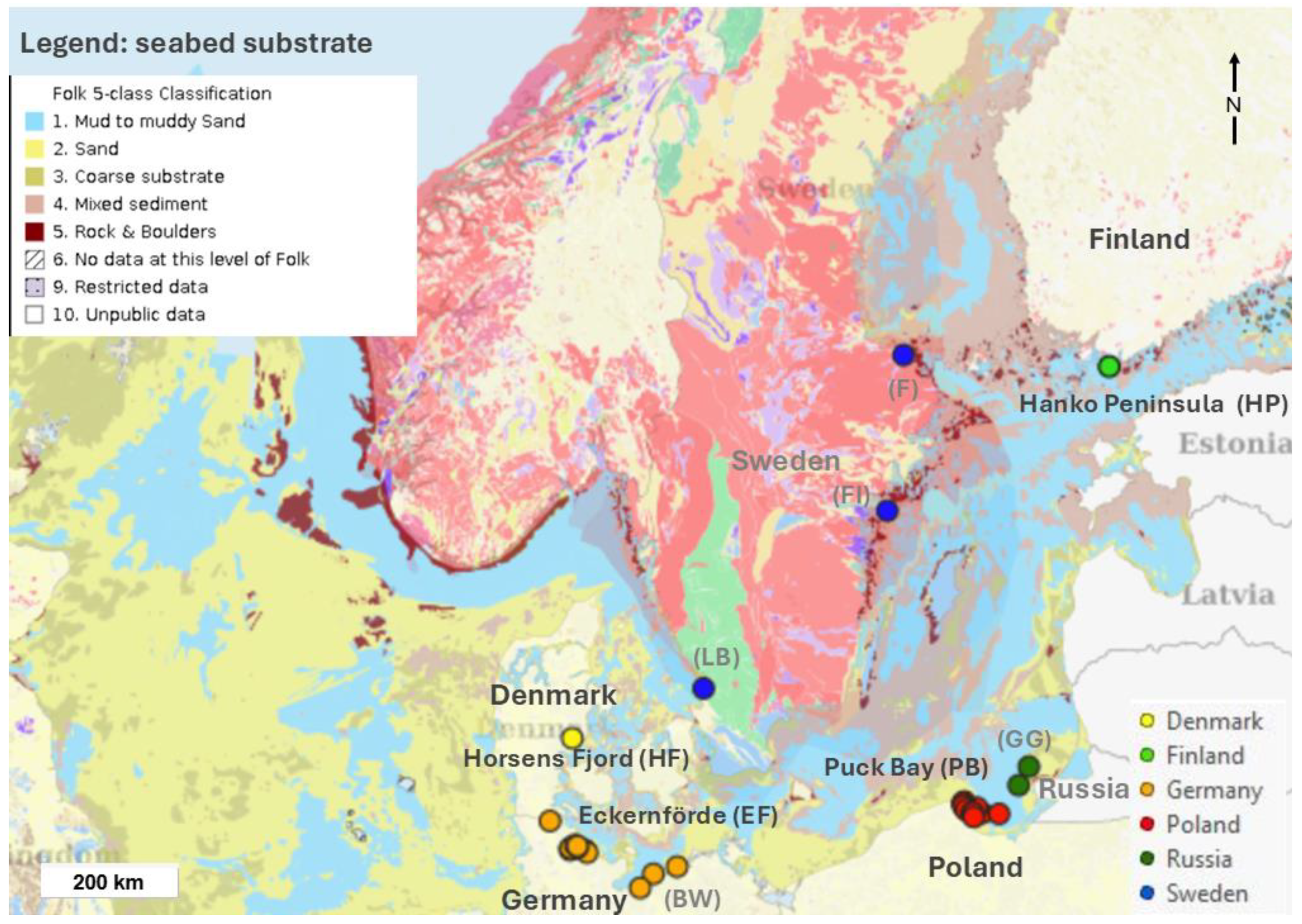


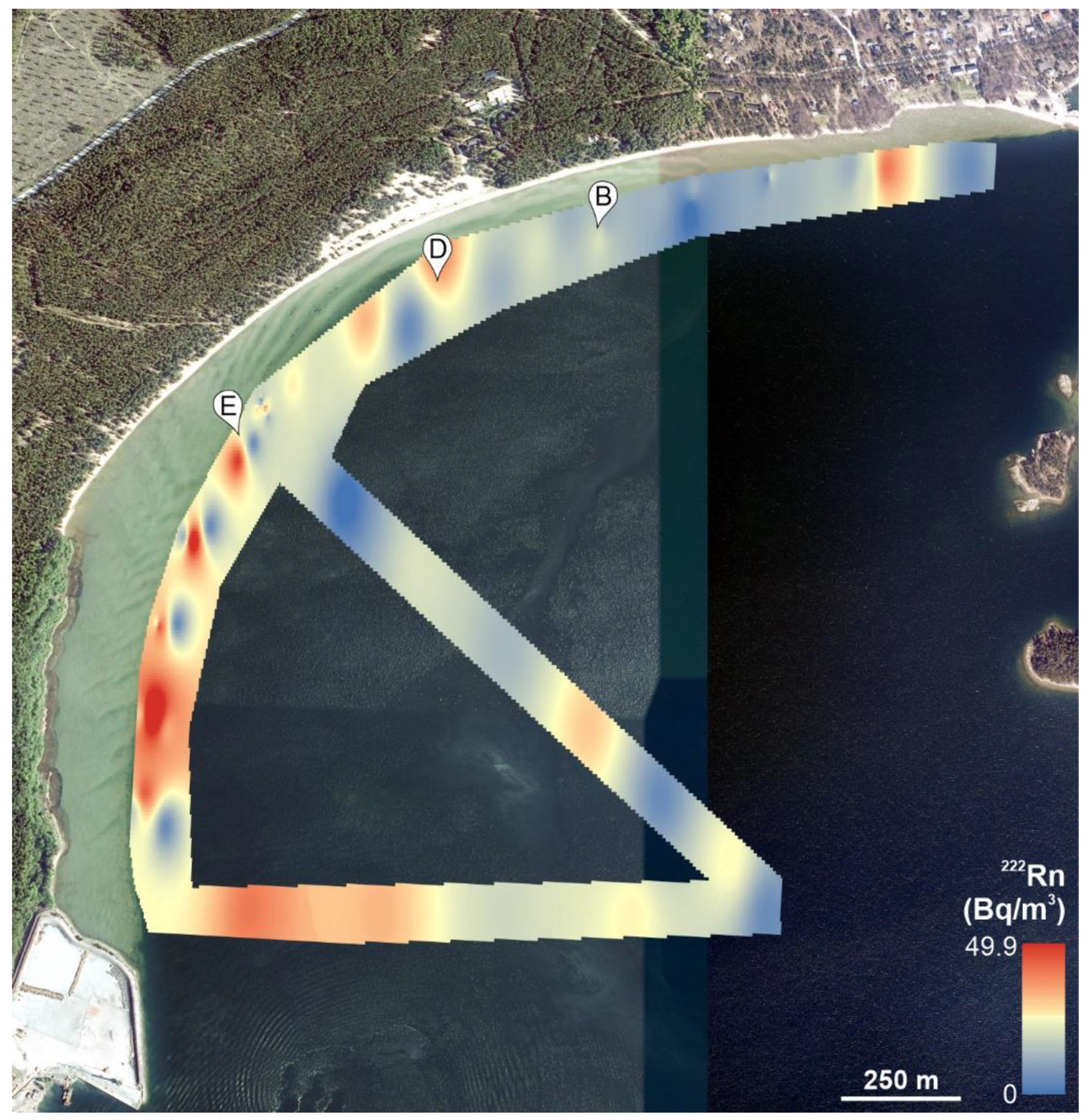
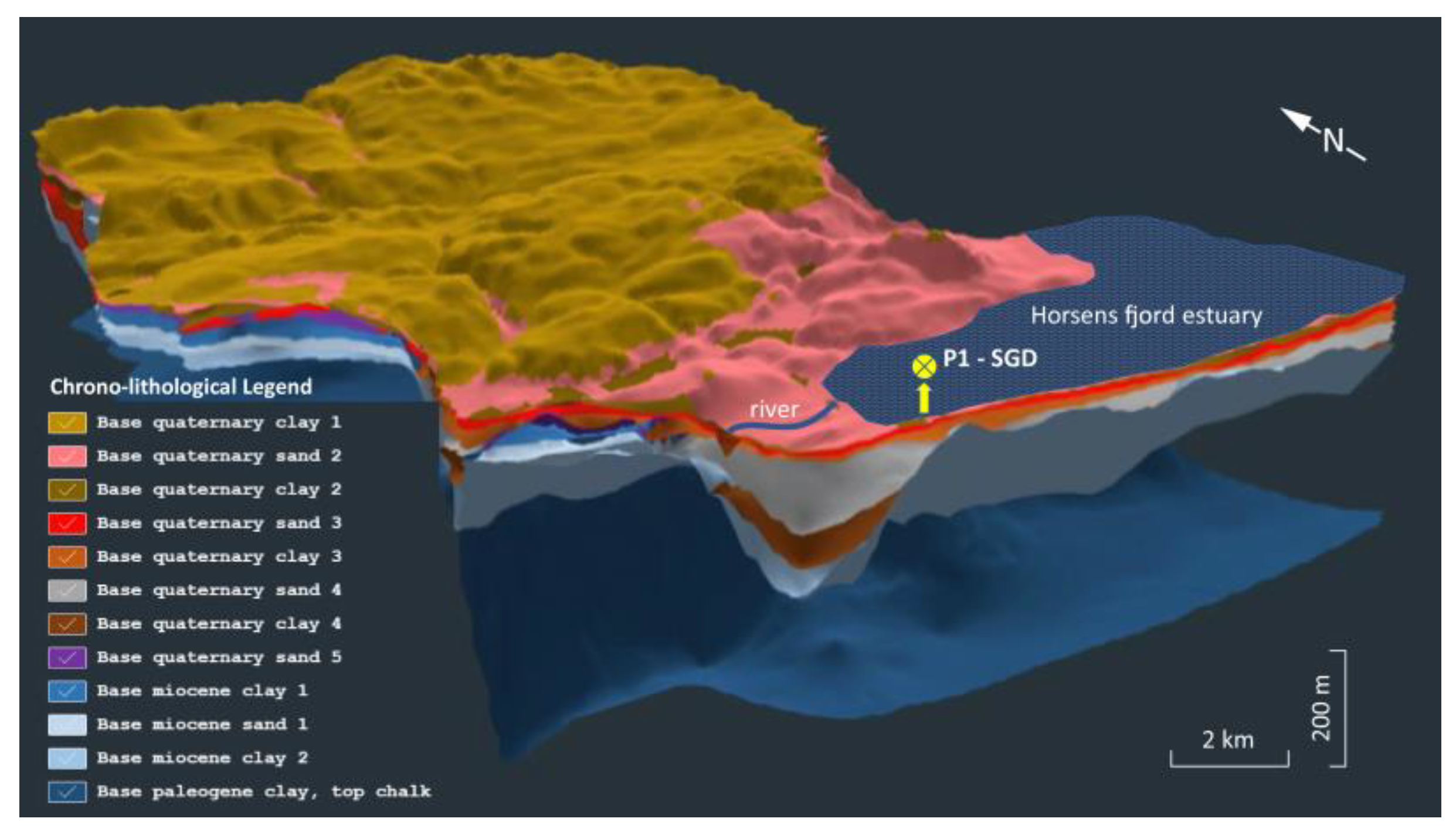
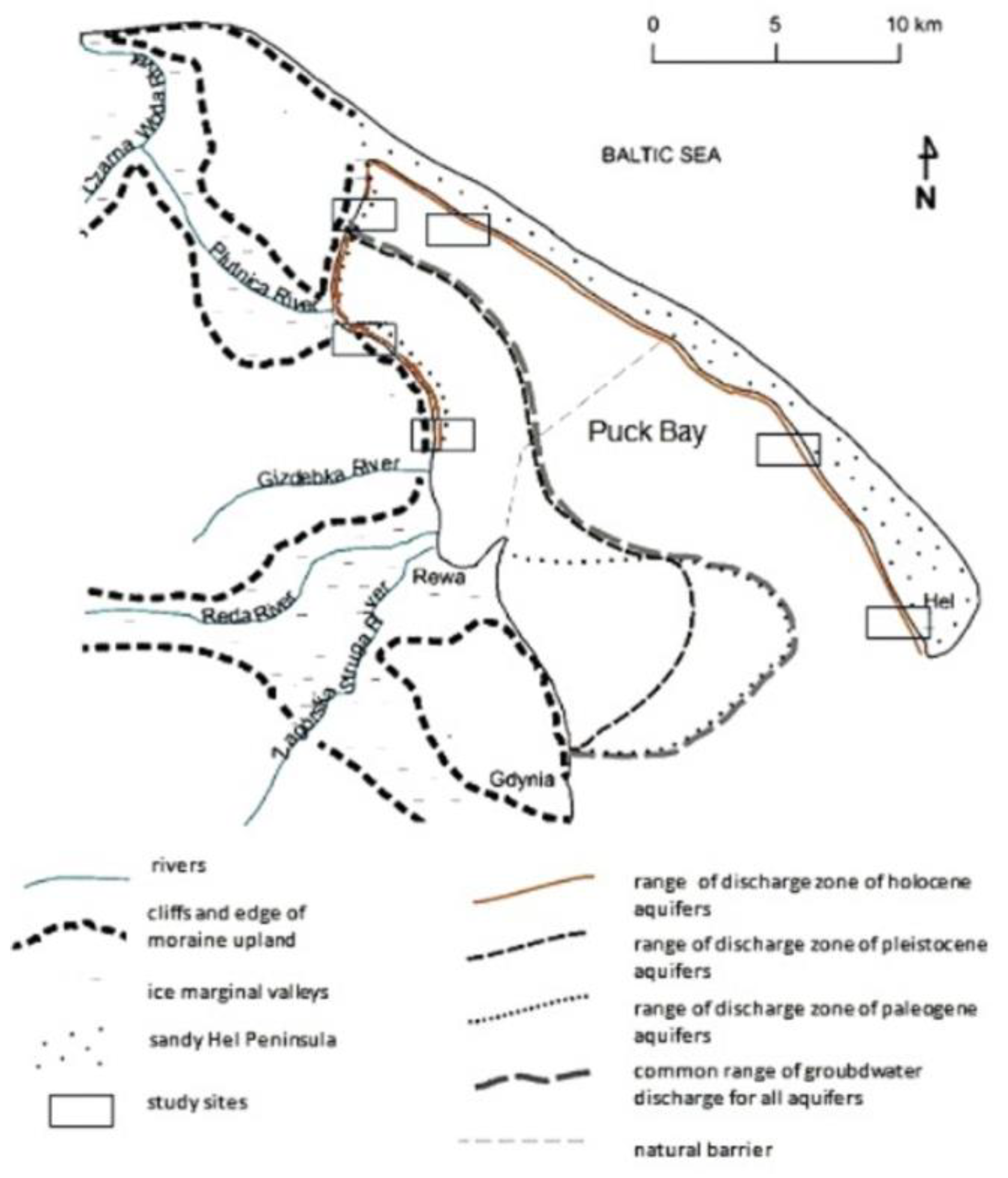
Disclaimer/Publisher’s Note: The statements, opinions and data contained in all publications are solely those of the individual author(s) and contributor(s) and not of MDPI and/or the editor(s). MDPI and/or the editor(s) disclaim responsibility for any injury to people or property resulting from any ideas, methods, instructions or products referred to in the content. |
© 2025 by the authors. Licensee MDPI, Basel, Switzerland. This article is an open access article distributed under the terms and conditions of the Creative Commons Attribution (CC BY) license (https://creativecommons.org/licenses/by/4.0/).
Share and Cite
Hinsby, K.; Scholten, J.; Virtasalo, J.; Szymczycha, B.; Leth, J.O.; Andersen, L.T.; Ondracek, M.; Tulstrup, J.; Latacz, M.; Bannasch, R. Towards a Digital Information Platform for Locating and Assessing Environmental Impacts of Submarine Groundwater Discharge: Examples from the Baltic Sea. J. Mar. Sci. Eng. 2025, 13, 614. https://doi.org/10.3390/jmse13030614
Hinsby K, Scholten J, Virtasalo J, Szymczycha B, Leth JO, Andersen LT, Ondracek M, Tulstrup J, Latacz M, Bannasch R. Towards a Digital Information Platform for Locating and Assessing Environmental Impacts of Submarine Groundwater Discharge: Examples from the Baltic Sea. Journal of Marine Science and Engineering. 2025; 13(3):614. https://doi.org/10.3390/jmse13030614
Chicago/Turabian StyleHinsby, Klaus, Jan Scholten, Joonas Virtasalo, Beata Szymczycha, Jørgen O. Leth, Lærke T. Andersen, Maria Ondracek, Jørgen Tulstrup, Michał Latacz, and Rudolf Bannasch. 2025. "Towards a Digital Information Platform for Locating and Assessing Environmental Impacts of Submarine Groundwater Discharge: Examples from the Baltic Sea" Journal of Marine Science and Engineering 13, no. 3: 614. https://doi.org/10.3390/jmse13030614
APA StyleHinsby, K., Scholten, J., Virtasalo, J., Szymczycha, B., Leth, J. O., Andersen, L. T., Ondracek, M., Tulstrup, J., Latacz, M., & Bannasch, R. (2025). Towards a Digital Information Platform for Locating and Assessing Environmental Impacts of Submarine Groundwater Discharge: Examples from the Baltic Sea. Journal of Marine Science and Engineering, 13(3), 614. https://doi.org/10.3390/jmse13030614









